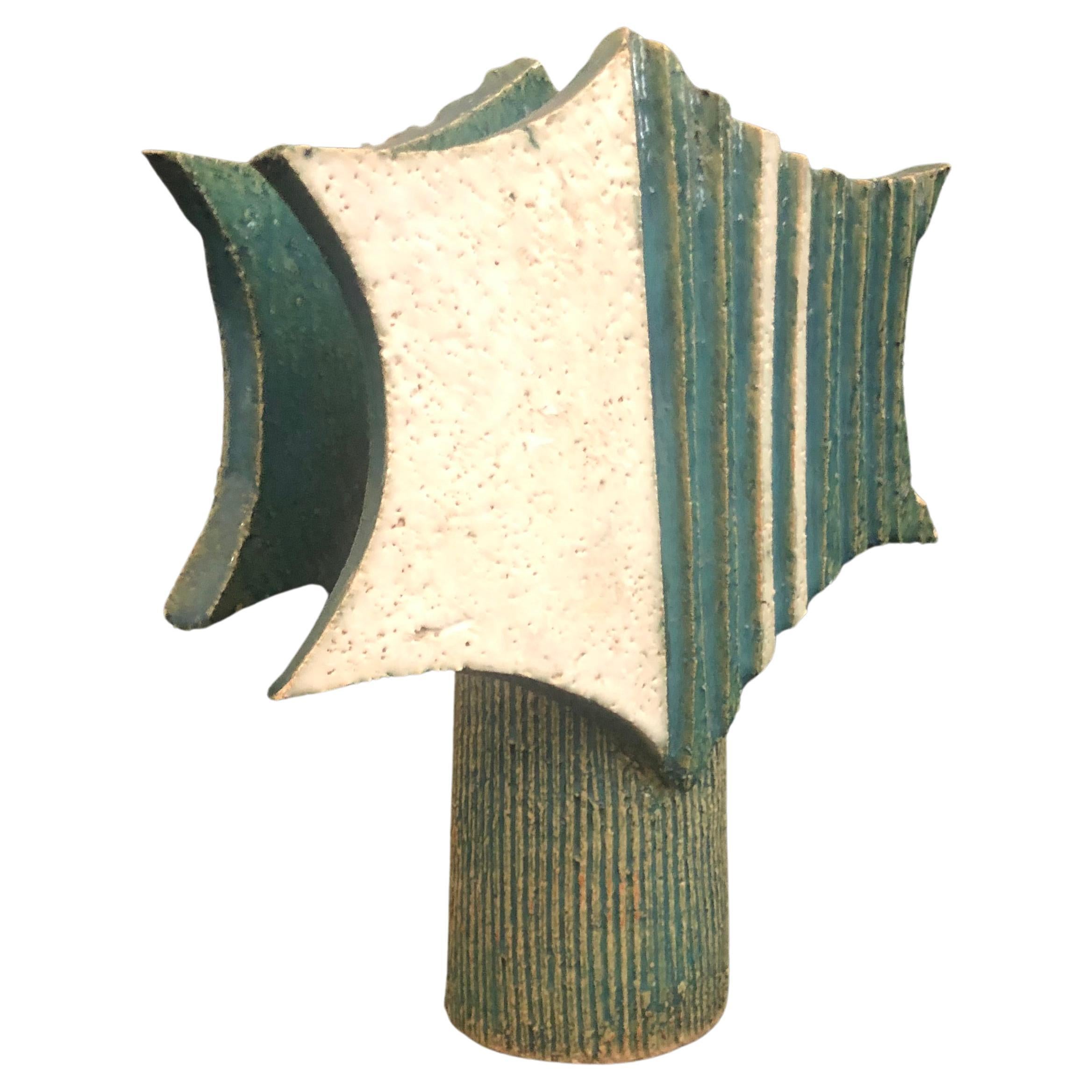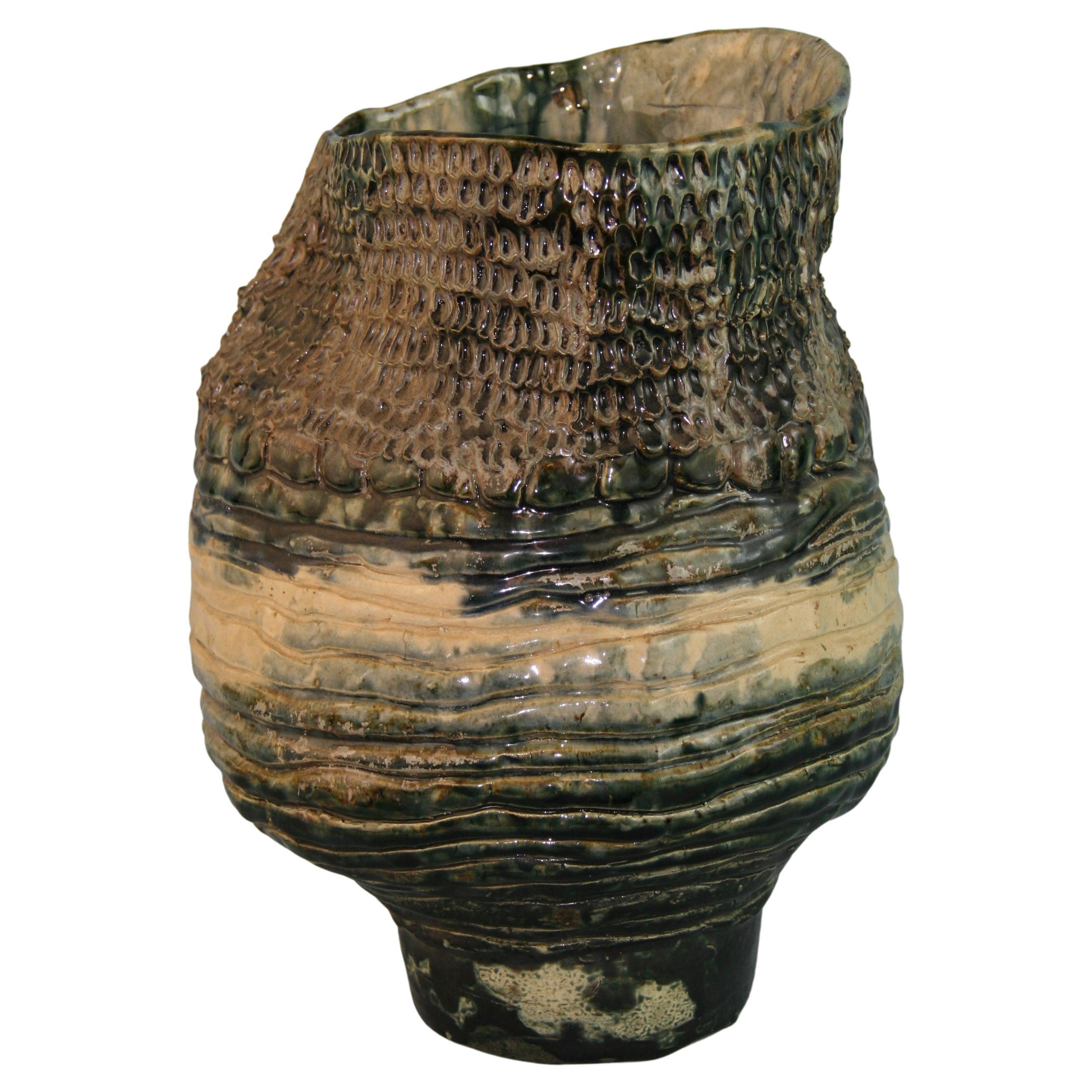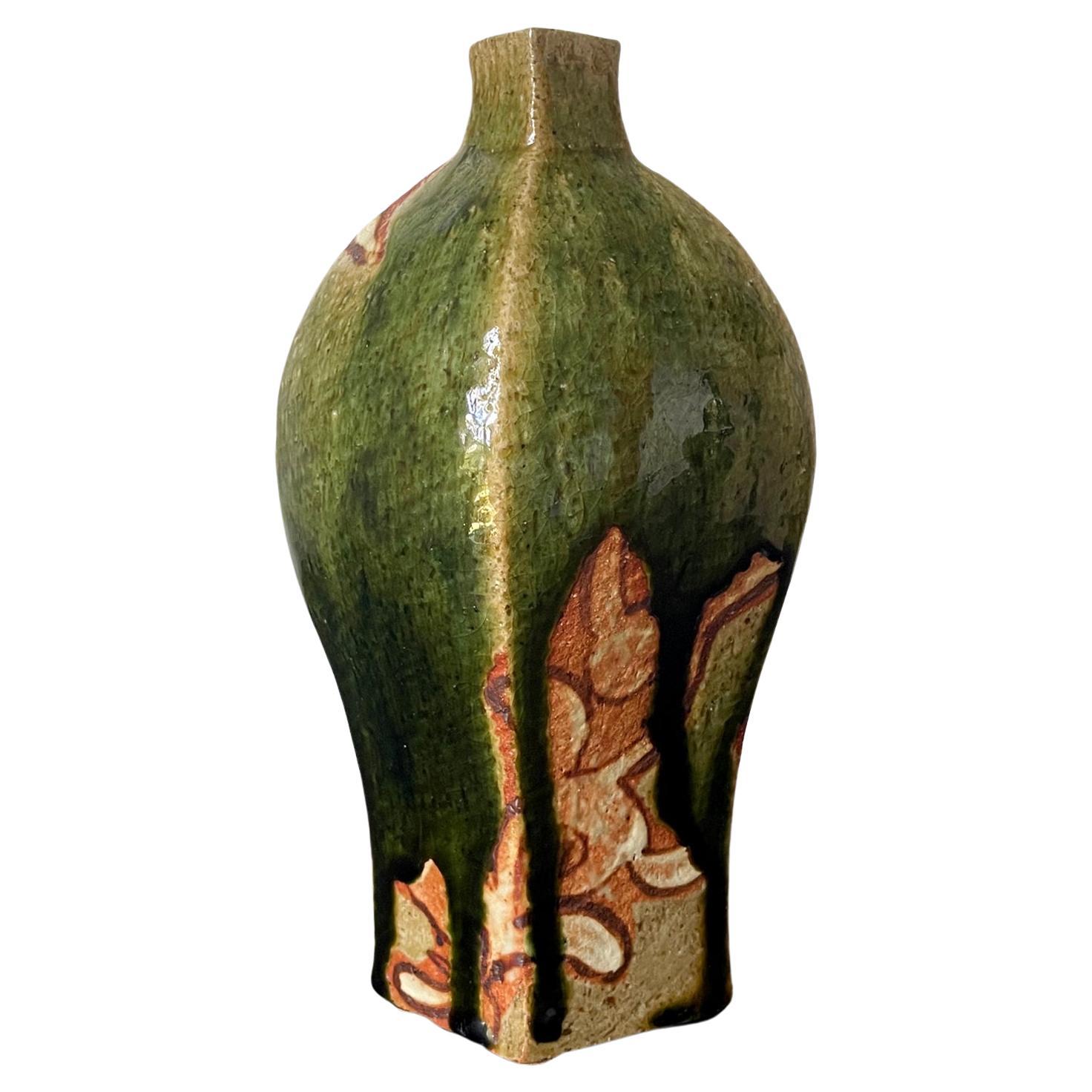Items Similar to Hagi Ikebana Vase by Kyusetsu Miwa X Japanese Studio Pottery
Want more images or videos?
Request additional images or videos from the seller
1 of 19
Hagi Ikebana Vase by Kyusetsu Miwa X Japanese Studio Pottery
About the Item
A stoneware vase with white dripping glaze from Hagi by Kyusetsu Miwa X (1895-1981), Showa Period. The vase is in the shape of "Double Gourd" with a bulbous body and a slightly flared lip. The body displays a reddish clay with the top part covered in a free dripping creamy white glaze. It is used as ikebana for flower display during tea ceremony and comes with its original storage box tomobako with inscription of the title, the artist's signature and seal. The vase is also press signed on the base. The vase display beautiful surface with glaze, some kiln burst and crackle as well, adding a wabi-sabi character to the piece. The size shown is the vase; The size of the box is 11.625hx6.25wx6.25d.
Kyusetsu Miwa X was given the honor of Living National Treasure in Japan in 1970 for his work on reviving traditional Hagi ware. The below except is a history of Miwa family from an article written by Robert Yellin published in The Japan Times in 2003.
"The Miwa family is one of the most important potting families in all of Japan. Their kiln was established in Kanbun 3 (1663) in the Matsumoto area of Hagi (in Yamaguchi Prefecture on the Sea of Japan coast) in order to produce tea utensils for Lord Mori Terumoto. The successive generations of Miwa potters have produced all sorts of works besides tea ware, including Raku ware (Kyusetsu I and IV studied in Kyoto), figurines of mythical creatures (Kyusetsu VI and VII), and vessels for the table.
In the 1930s, when there was a “Return to Momoyama” revival (the Way of Tea was crystallized in the Momoyama Period, 1573-1615), Miwa Kyuwa (Kyusetsu X) revitalized the Hagi tea world with his warm and sensuous chawan and other tea utensils, while his younger brother Miwa Jusetsu (Kyusetsu XI) added power and strength with his Oni-Hagi (devil-Hagi) chawan (see this column, Jan. 22, 2000). The brothers were named as living national treasures for their Hagi wares in 1970 and 1983, respectively."
- Creator:Kyusetsu Miwa X (Artist)
- Dimensions:Height: 10.45 in (26.55 cm)Diameter: 5.2 in (13.21 cm)
- Style:Japonisme (Of the Period)
- Materials and Techniques:
- Place of Origin:
- Period:
- Date of Manufacture:1940s-1950s
- Condition:Wear consistent with age and use. Some wear on the storage box, kiln wear on the base, kiln character like burst and crackle as shown.
- Seller Location:Atlanta, GA
- Reference Number:1stDibs: LU945015545141
About the Seller
5.0
Platinum Seller
These expertly vetted sellers are 1stDibs' most experienced sellers and are rated highest by our customers.
Established in 2006
1stDibs seller since 2010
479 sales on 1stDibs
Typical response time: <1 hour
- ShippingRetrieving quote...Ships From: Atlanta, GA
- Return PolicyA return for this item may be initiated within 2 days of delivery.
More From This SellerView All
- Japanese Ceramic Ikebana Vase Bizen Ware Nanba KoyoLocated in Atlanta, GAA tall vintage ceramic vase with handle from Japan (20th century) by Nanba Koyo. Made in the tradition of Bizen ware, the vase has a modern aesthetic with a...Category
20th Century Japanese Japonisme Ceramics
MaterialsCeramic
- Modern Japanese Studio Pottery Oribe Vase by Ken MatsuzakiBy Ken MatsuzakiLocated in Atlanta, GAA contemporary studio ceramic vase made by Japanese potter Ken Matsuzaki (1950-). The vase showcases a geometrical spindle form, rather distinguishingly modern. It is covered with a thick dripping Oribe green glaze partially revealing the unglazed part of the body, which is decorated with scrolling pattern in left by ash glaze. The work is rooted in both Yohen Shino glaze technique and Oribe tradition, but it is an innovative reinterpretation of the ancient aesthetic. The base is marked with the artist's signature. The vase comes with an inscribed tomobako storage box with the artist's bio and wrapping cloth with seal. The vase measures 9"h x 5.5"w x 4"d. Ken Matsuzaki’s haptic ceramics bring a contemporary approach to traditional Japanese ceramicware, most notably 16th-century Oribe pottery...Category
Early 2000s Japanese Modern Ceramics
MaterialsCeramic
- Asian Flambe Studio Pottery VaseBy Kyoto PotteryLocated in Atlanta, GAA garlic bottle vase in an archaic Chinese form, but likely Japanese in origin. Several circumventing grooves however, suggest a more modern age. It was done in a brilliant purple glaze over a robin egg blue background glaze. The bubbling and bursting effects during the firing renders the surface an artistic spotting effect. The color pallet recalls the Classic Jun Yao...Category
Antique Late 19th Century Japanese Japonisme Ceramics
MaterialsCeramic
- Modern Japanese Studio Pottery Oribe Moon Flask Vase by Ken MatsuzakiBy Ken MatsuzakiLocated in Atlanta, GAA contemporary studio ceramic vase made by Japanese potter Ken Matsuzaki (1950-). The vase showcases distinguished "moon flask" form with shoulder loops. The moon flask form was widely recorded first in Tang Dynasty China, most likely arrived from the Mideast countries via the silk road. It was originally used as drink vessel for the nomads and the loops were used to tie it to the horse-centered owner. The exotic form persisted in Chinese ceramic production through Ming to Qing dynasty. The form is unusual in Ken Matsuzaki's work. The artist covered the vase with a thick dripping Oribe green glaze partially revealing the unglazed part of the body, which is decorated with scrolling pattern in left by ash glaze. The work is rooted in both Yohen Shino glaze technique and Oribe tradition, but interestingly it also paid homage to Sancai pottery in Tang Dynasty when green glaze was prominently used to drip and splash onto the pottery. Viewing the vase, one can see in this harmonious piece, the innovative reinterpretation of ancient aesthetics that cross the cultures, geology and time. The base is marked with the artist's signature. The vase comes with an inscribed tomobako storage box with the artist's bio and wrapping cloth with seal. The vase measures 8.6"h x 7"w x 2"d. Ken Matsuzaki’s haptic ceramics bring a contemporary approach to traditional Japanese ceramicware, most notably 16th-century Oribe pottery...Category
Early 2000s Japanese Modern Ceramics
MaterialsCeramic
- Modern Japanese Ceramic Shigaraki Ikebana Vase Takahashi ShunsaiLocated in Atlanta, GAA tall ceramic vase made in the tradition of Shigaraki ware by Japanese potter Takahashi Shunsai (1927-2011), the fourth heir of the famed Rakusai lineage of potters. The vase is heavily potted in the reddish sandy Shigaraki clay. It has a Classic vase form made for Ikebana display. The surface is thickly draped with natural ash glaze that deposited onto the body during the firing process in the kiln. It also features decoration of carved lines. Nuggets of feldspar were incorporated in the clay and exposed onto the surface as crystal like jewels. Substantial and archaic looking, the vase also has a strong modern appeal due to its Mingei styling. It was signed on the base with a pressed seal Shunsai as shown. The vase comes with its original wood storage box (tomobako) with bears the title and signature in Kanji and a seal. It also retains a paperwork noting the artist's biography and practice philosophy in Japanese. Born in Shigaraki, Shunsai was the second son of renowned potter Takahashi Rakusai...Category
1990s Japanese Modern Ceramics
MaterialsCeramic
- Modern Japanese Studio Pottery Oribe Tea Pot by Ken MatsuzakiBy Ken MatsuzakiLocated in Atlanta, GAA contemporary studio ceramic tea pot with metal handle made by Japanese potter Ken Matsuzaki (1950-). The stoneware tea pot showcases a thick dripping Oribe green glaze partially revealing the unglazed part of the body, which is decorated with scrolling pattern of ash glaze. The work is rooted in both Yohen Shino glaze technique and Oribe tradition, but interestingly it also paid homage to Sancai pottery...Category
Early 2000s Japanese Modern Ceramics
MaterialsCeramic
You May Also Like
- 1960s, Japanase Ikebana Studio Pottery VaseLocated in London, GBA 1960s Japanase ikebana studio pottery vase. Star form panels with central cylinder vase with vertical grooves finished in an off-white and green glaze. 'Made in Japan' stamp to base. Ikebana ("arranging flowers" or "making flowers alive") is the Japanese art of flower arrangement.[ It is also known as kado ( "way of flowers"). The tradition dates back to Heian period...Category
Mid-20th Century Japanese Mid-Century Modern Ceramics
MaterialsPottery
- Japanese Studio Pottery Lava Glazed VaseLocated in Douglas Manor, NY1149 Beautiful Japanese studio lava glazed vaseCategory
Vintage 1930s Ceramics
MaterialsPottery
- Japanese Mid-Century Modern Studio Pottery VaseLocated in New York, NYJapanese Mid-Century Modern art studio pottery vase with luster glaze on diminutive tripod legs.Category
Mid-20th Century Japanese Mid-Century Modern Ceramics
MaterialsPottery
- Japan, Set of Two Japanese Vases for Flower Arrangement, IkebanaLocated in PARIS, FRRare ceramic set of hand made vases Japanese flower arrangements. Very attractive even without flowers. Hand made, hand painted and signed by the ar...Category
Mid-20th Century Japanese Vases
MaterialsCeramic
- Japanese Shino Pottery Vase by Tamaoki YasuoBy Tamaoki YasuoLocated in Prahran, VictoriaShino pottery vase in deep murasaki and white by contemporary Japanese ceramic artist Tamaoki Yasuo. The vase is an iconic representation of his style. I...Category
20th Century Japanese Ceramics
MaterialsCeramic
- Japanese Porcelain Studio Art VaseLocated in Hudson, NYWith lovely magnolia tree in bloom and finch on blue background. Signed: Fukugawa.Category
20th Century Japanese Meiji Ceramics
MaterialsPorcelain
Recently Viewed
View AllMore Ways To Browse
20th X
Living National
Flower Display
Vintage Flower Displays
Vintage Flower Display
Traditional Vintage Japanese Art
Kiln Japanese
1940s Japanese
Vintage Japanese Flower Art
Art Pottery Flowers
Japanese Ceramic Art Pottery
Japanese Clay Artist
White Clay Pottery
Japanese Studio Ceramics
Signed Studio Art Pottery
Brown Japanese Pottery
Japanese Stoneware Ceramics
Vintage Asian Pottery





